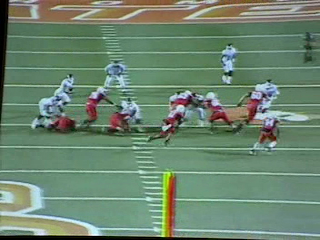one bad ass offensive mind
In this first installment, we'll look at how Brewer uses his permiter run game to attack edge blitzers and SCIF players.standard strong-side fire zone
examples of fire zone blitzes
OSU's 3 ways to take advantage of the fire zone
INTO the fire zone (teeth)
- Full zone boss scheme
- Zone option scheme
- TE full zone stretch
- TE or nub lead zone stretch
- TE inside zone
- TE 1 back power O
- TE or nub 2 back power O
Narrow it down based on stages of the game. Most defenses have a signature on when they will run these. Look for an MO based on;
- down and distance
- areas of the field
- personnel groupings
- 4 minute offense
- start of series / half
- sudden change, etc
Timing is everything when beating the fire zone
The key element that all offenses have is the snap count. Get the defense to show their hand by controlling the pace of the game. It is critical to alter your tempo and snap count to disrupt disguise, timing, and overall execution of the fire zone.
Brewere recommneds using the “early” or “late” concept. Snap the ball fast or late, to keep the defense out of rhythm. Alter the tempo by going on first sound, on normal cadence, using freeze, double-freeze, using a long count, having the quarterback double-kick during the cadence, and/or use hurry-up.
“If they’re not showing you (their intentions), you’re not doing enough NASCAR.
[which means] You have slowed the tempo down so much, they have got you figured out. They’re holding their water”
Additional coaching points in handling the blitz;
- The outside receiver has man-on and looks to gain inside leverage.
- #2 to the call (inside receiver) has high safety (if safety comes to blitz, don’t block him – take his replacement), we want to pitch.
- The QB secures snap, steps with playsidde foot and immediately attacks the D gap player to pitch key.
- Playside Tackle & playside TE stretch step and work to Playside LB.
- Playside Guard & Center zone step and work to backside LB.
- The backside receiver has deep cutoff.
The basic plan of attack is using speed option to the open end and Zone option to TE side
Nothing really changes in execution when you run it open or closed, because you’re still pitching off the 4th defender (1st guy outside the box).With the fire zone, Brewer also mentions that it is important to cue the Defensive End (either from coaches in the box or the players on the field) . Whether it is high school, junior high, or pros, if he’s rushing, he’s in the ground (and coming) in a scissors stance. Watch for the one who is getting square and getting light in his hands, this will indicate that the end is dropping away from the overload, which will determine which direction you will attack (based on your philosophy of going into or away from the blitz).
The following are examples of using these perimeter runs to attack the zone blitz.
Attacking the closed end / nub to the boundary;





























No comments:
Post a Comment